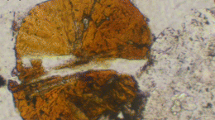Abstract
Middendorfite, a new mineral species, has been found in a hydrothermal assemblage in Hilairite hyperperalkaline pegmatite at the Kirovsky Mine, Mount Kukisvumchorr apatite deposit, Khibiny alkaline pluton, Kola Peninsula, Russia. Microcline, sodalite, cancrisilite, aegirine, calcite, natrolite, fluorite, narsarsukite, labuntsovite-Mn, mangan-neptunite, and donnayite are associated minerals. Middendorfite occurs as rhombshaped lamellar and tabular crystals up to 0.1 × 0.2 × 0.4 mm in size, which are combined in worm-and fanlike segregations up to 1 mm in size. The color is dark to bright orange, with a yellowish streak and vitreous luster. The mineral is transparent. The cleavage (001) is perfect, micalike; the fracture is scaly; flakes are flexible but not elastic. The Mohs hardness is 3 to 3.5. Density is 2.60 g/cm3 (meas.) and 2.65 g/cm3 (calc.). Middendorfite is biaxial (−), α = 1.534, β = 1.562, and γ = 1.563; 2V (meas.) = 10°. The mineral is pleochroic strongly from yellowish to colorless on X through brown on Y and to deep brown on Z. Optical orientation: X = c. The chemical composition (electron microprobe, H2O determined with Penfield method) is as follows (wt %): 4.55 Na2O, 10.16 K2O, 0.11 CaO, 0.18 MgO, 24.88 MnO, 0.68 FeO, 0.15 ZnO, 0.20 Al2O3, 50.87 SiO2, 0.17 TiO2, 0.23 F, 7.73 H2O; −O=F2−0.10, total is 99.81. The empirical formula calculated on the basis of (Si,Al)12(O,OH,F)36 is K3.04(Na2.07Ca0.03)Σ2.10(Mn4.95Fe0.13Mg0.06Ti0.03Zn0.03)Σ5.20(Si11.94Al0.06)Σ12O27.57(OH)8.26F0.17 · 1.92H2O. The simplified formula is K3Na2Mn5Si12(O,OH)36 · 2H2O. Middenforite is monoclinic, space group: P21/m or P21. The unit cell dimensions are a = 12.55, b = 5.721, c = 26.86 Å; β = 114.04°, V = 1761 Å3, Z = 2. The strongest lines in the X-ray powder pattern [d, Å, (I)(hkl)] are: 12.28(100)(002), 4.31(81)(11\(\overline 4 \)), 3.555(62)(301, 212), 3.063(52)(008, 31\(\overline 6 \)), 2.840(90)(312, 021, 30\(\overline 9 \)), 2.634(88)(21\(\overline 9 \), 1.0.\(\overline 1 \)0, 12\(\overline 4 \)), 2.366(76)(22\(\overline 6 \), 3.1.\(\overline 1 \)0, 32\(\overline 3 \)), 2.109(54)(42–33, 42–44, 51\(\overline 9 \), 414), 1.669(64)(2.2.\(\overline 1 \)3, 3.2.\(\overline 1 \)3, 62\(\overline 3 \), 6.1.\(\overline 1 \)3), 1.614(56)(5.0.\(\overline 1 \)6, 137, 333, 71\(\overline 1 \)). The infrared spectrum is given. Middendorfite is a phyllosilicate related to bannisterite, parsenttensite, and the minerals of the ganophyllite and stilpnomelane groups. The new mineral is named in memory of A.F. von Middendorff (1815–1894), an outstanding scientist, who carried out the first mineralogical investigations in the Khibiny pluton. The type material of middenforite has been deposited at the Fersman Mineralogical Museum, Russian Academy of Sciences, Moscow.
Similar content being viewed by others
References
A. I. Brusnitsyn, E. V. Starikova, S. V. Krivovichev, and N. V. Chukanov, “Barium Parsettensite from the Kyzyl-Tash Manganese Deposit (Southern Urals),” Zap. Vseross. Mineral. O-va 128(6), 79–90 (1999).
N. V. Chukanov, I. V. Pekov, A. E. Zadov, et al., “New Minerals Tsepinite-K and Paratsepinite-Ba and Their Relationships with Other Representatives of the Labuntsovite Group,” Zap. Vseross. Mineral. O-va 132(1), 38–51 (2003).
P. J. Dunn, D. R. Peacor, and S.-C. Su, “Franklinphilite, the Manganese Analog of Stilpnomelane, from Franklin, New Jersey,” Miner. Record 23, 465–468 (1992).
R. A. Eggleton and S. Guggenheim, “A Re-Examination of the Structure of Ganophyllite,” Mineral. Mag. 50, 307–315 (1986).
R. A. Eggleton and S. Guggenheim, “The Use of Electron Optical Methods to Determine the Crystal Structure of a Modulated Phyllosilicate: Parsettensite,” Am. Miner. 79, 426–437 (1994).
P.J. Heaney, J. E. Post, and H. T. Evans, Jr., “The Crystal Structure of Bannisterite,” Clays Clay Miner. 40, 129–144 (1992).
D. A. Jefferson, “The Crystal Structure of Ganophyllite, a Complex Manganese Aluminosilicate. I: Polytypism and Structure Variation,” Acta Crystal. A34, 491–497 (1978).
T. Kato, “The Crystal Structure of Ganophyllite; Monoclinic Subcell,” Miner. J. (Japan), No. 10, 1–13 (1980).
S. V. Krivovichev, V. N. Yakovenchuk, Th. Armbruster, et al., “Synchrotron X-Ray Diffraction Study of the Structure of Shafranovskite, K2Na3(Mn,Fe,Na)4[Si9(O,OH)27] (OH)2 · nH2O, a Rare Manganese Phyllosilicate from the Kola Peninsula, Russia,” Am. Miner. 89, 1816–1821 (2004).
J. A. Mandarino, “The Gladstone-Dale Relationship: Part IV. The Compatibility Concept and Its Application,” Can. Mineral. 19, 441–450 (1981).
A. Th. Middendorff, “Bericht Ueber Einen Abstecher Durch das Innere von Lappland, Waehrend der Sommer-Expedition, im Jahre 1840,” Beitraege zur Kenntniss des Russischen Reiches 11, 137–183 (1845).
Minerals. Reference-Book, Ed. by F. V. Chukhrov (Nauka, Moscow, 1992), Vol. IV, Issue 2 [in Russian].
D. R. Peacor, P. J. Dunn, and W. B. Simmons, “Eggletonite, the Na Analogue of Ganophyllite,” Miner. Mag. 48, 93–96 (1984).
I. V. Pekov and A. S. Podlesny, Mineralogy of the Kukisvumchorr Deposit (Alkaline Pegmatites and Hydrothermalites) (Zemlya, Moscow, 2004) [in Russian].
I. V. Pekov, N. V. Chukanov, N. N. Kononkova, et al., “Kukharenkoite-(La) Ba2(La,Ce)(CO3)3F: A New Mineral Species of the Khibiny Massif, Kola Peninsula,” Zap. Vseross. Mineral. O-va 132(3), 55–64 (2003).
I. V. Pekov, N. V. Chukanov, G. Ferraris, et al., “Shirokshinite, K(Na Mg2)Si4O10F2, a New Mica with Octahedral Na from Khibiny Massif, Kola Peninsula: Descriptive Data and Structural Disorder,” Eur. J. Mineral. 15, 447–454 (2003).
I. V. Pekov, N. V. Chukanov, Yu. S. Lebedeva, et al., “Potassicarfvedsonite, KNa2Fe 2+4 Fe3+Si8O22(OH)2, a K-Dominant Amphibole of the Arfvedsonite Series from Agpaitic Pegmatites—Mineral Data, Structure Refinement and Disorder in the A Site,” N. Jahrb. Miner. Monatsh., No. 12, 555–574 (2004).
M. L. Smith and C. Frondel, “The Related Layered Minerals Ganophyllite, Bannisterite and Stilpnomelane,” Miner. Mag. 36, 893–913 (1968).
Author information
Authors and Affiliations
Corresponding author
Additional information
Original Russian Text © I.V. Pekov, N.V. Chukanov, V.T. Dubinchuk, A.E. Zadov, 2006, published in Zapiski Rossiiskogo Mineralogicheskogo Obshchestva, 2006, No. 3, pp. 42–52.
Considered by the Commission on New Minerals and Mineral Names, Russian Mineralogical Society, June 22, 2005. Approved by the Commission on New Minerals and Mineral Names, International Mineralogical Association, September 5, 2005 (proposal 2005-028).
Rights and permissions
About this article
Cite this article
Pekov, I.V., Chukanov, N.V., Dubinchuk, V.T. et al. Middendorfite, K3Na2Mn5Si12(O,OH)36 · 2H2O, a new mineral species from the Khibiny pluton, Kola Peninsula. Geol. Ore Deposits 49, 522–529 (2007). https://doi.org/10.1134/S1075701507070069
Received:
Issue Date:
DOI: https://doi.org/10.1134/S1075701507070069




